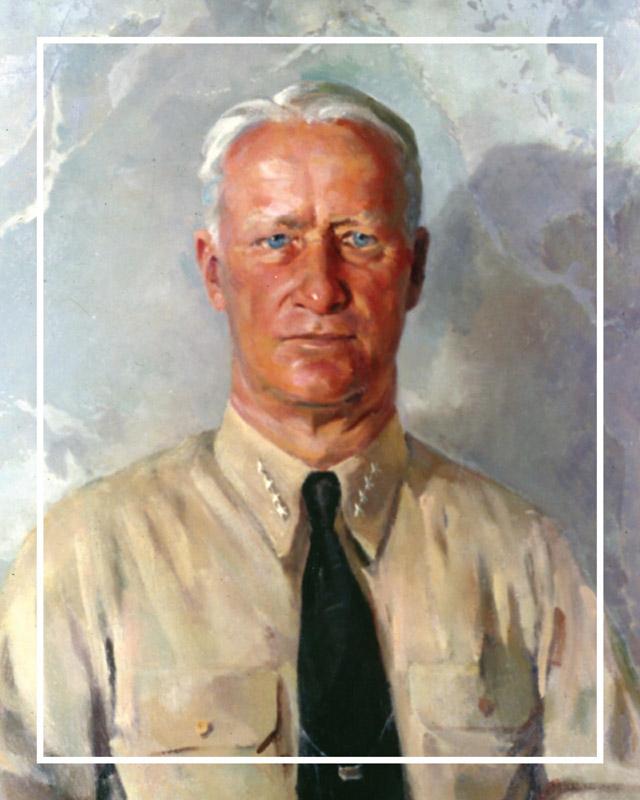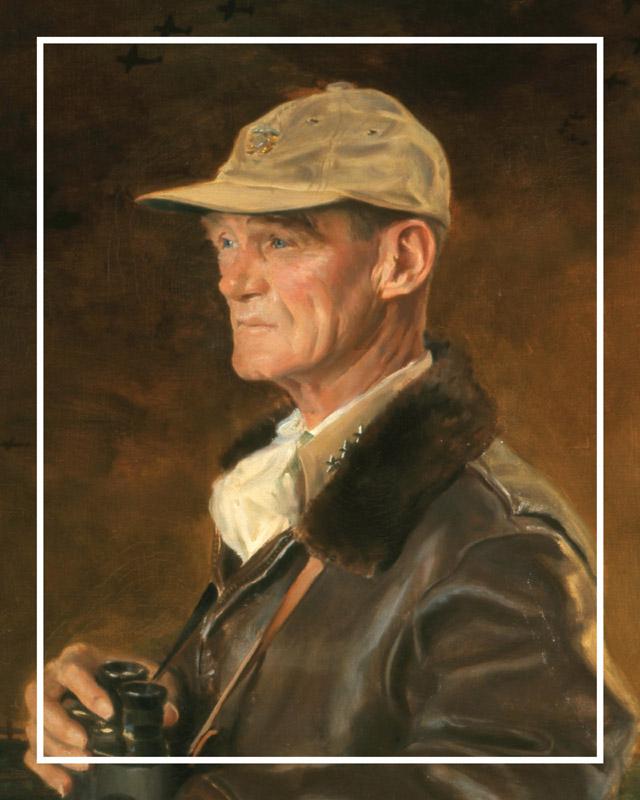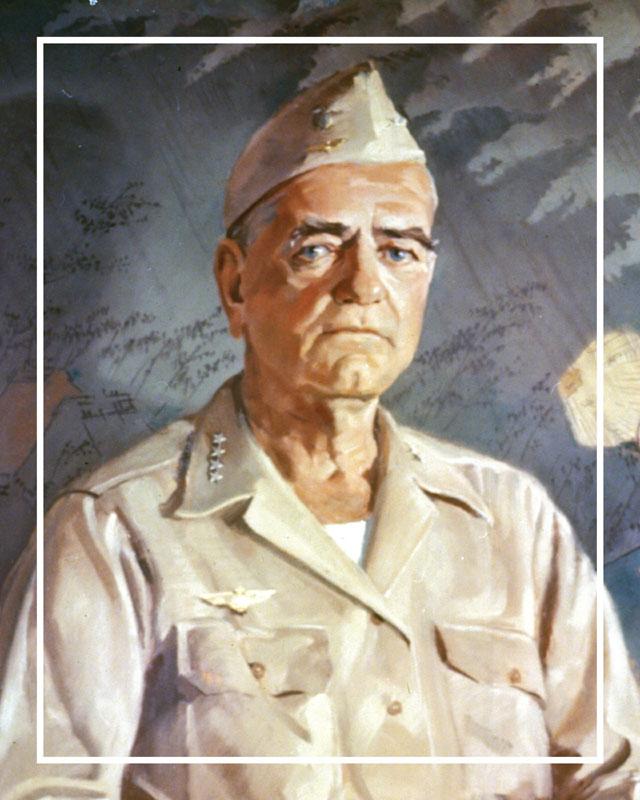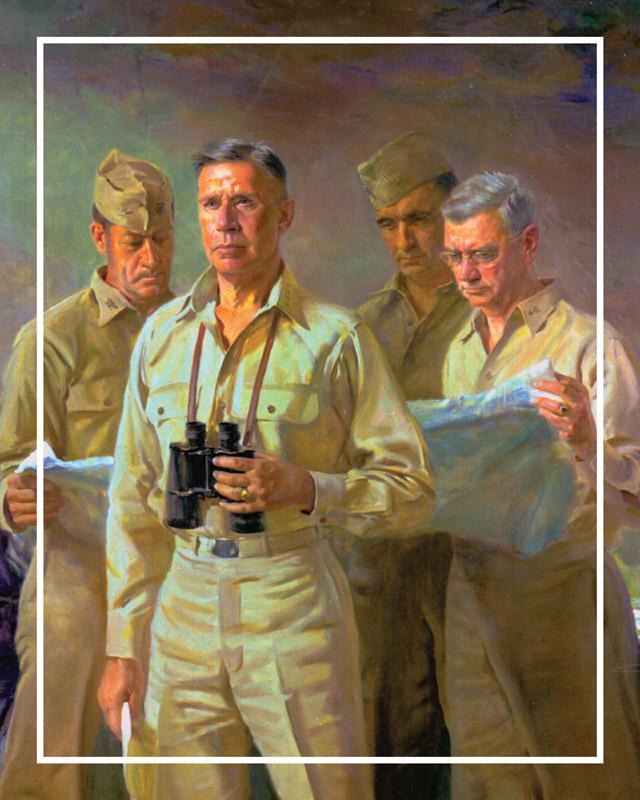-
"A ship is always referred to as 'she' because it costs so much to keep one in paint and powder."
Chester Nimitz started off as an officer from Texas, and eventually commanded the 1,000 U.S. naval ships that secured victory in the Pacific during World War II. He graduated seventh out of 114 fro...Read more
Chester Nimitz started off as an officer from Texas, and eventually commanded the 1,000 U.S. naval ships that secured victory in the Pacific during World War II. He graduated seventh out of 114 from the U.S. Naval Academy in 1905.
Nimitz commanded surface ships and submarines throughout most of his tenure in the Navy. After the attack on Pearl Harbor, Nimitz was transferred to command of the Pacific Fleet. He eventually split command over the theatre with General Douglas MacArthur. Nimitz was promoted to the rank of Fleet Admiral in December of 1944. Nimitz's strategies secured victories in the Mariana Islands, Philippine Sea, Caroline Islands, the Battle of Leyte Gulf, Iwo Jima and Okinawa. When the war came to an end, Admiral Nimitz signed on behalf of the United States during the formal Japanese surrender on September 2, 1945. He took over Admiral King's position as U.S. Navy's Chief of Naval Operations soon after. In this role, he dealt with the extremely difficult task of reducing America's naval strength. He also lent essential support to Admiral Hiram Rickover's nuclear propulsion program, which many credit as his greatest legacy.
-
"A bulldog of a fighter, a strategist blessed with an uncanny ability to foresee his enemy's next move, and a lifelong searcher after truth and trout streams, he was abov...Show more"A bulldog of a fighter, a strategist blessed with an uncanny ability to foresee his enemy's next move, and a lifelong searcher after truth and trout streams, he was above all else - perhaps above all other - a Naval Aviator." Admiral Arleigh Burke Show less
Marc Mitscher was a naval aviation pioneer despite his lackluster start in the service. Marc (or "Pete" to his classmates) Mitscher, ranked 113th out of 131in the graduating class of 1910 at the U....Read more
Marc Mitscher was a naval aviation pioneer despite his lackluster start in the service. Marc (or "Pete" to his classmates) Mitscher, ranked 113th out of 131in the graduating class of 1910 at the U.S. Naval Academy. Mitscher was among the Navy's first aviators, earning his wings in 1916.
In the 1920's Mitscher helped Rear Admiral William Moffett defend naval aviation against proposed independent military aircraft service and over the next two decades, he worked tirelessly to develop naval aviation into an effective combat force. By 1933, he had logged over 3,000 hours of flight time on 50 different models of aircraft. Mitscher commanded air wings assigned to the USS Langley (CV 1), and the USS Saratoga (CV 3). In 1941, Mitscher commanded the Navy's newest carrier, the USS Hornet (CV 8). American victories throughout the Marshall Islands were in part attributed to Mitscher's leadership as commander of Carrier Division Three. In 1944, he was put in charge of the newly formed fast carrier task force, where he transformed carrier tactics from raiding to strike forces. By 1945, Mitscher was the Deputy Chief of Naval Operations for Air. As a veteran air admiral, he spent his post-war years advocating carrier supremacy, demonstrated by his victories in the Pacific.
-
"The naval officer in the next war had better know his aviation, and good."
Admiral "Bull" Halsey lived up to his nickname - he actively took the fight to the enemy during World War II. A few years after graduating from the U.S. Naval Academy in 1904, Halsey served in Theo...Read more
Admiral "Bull" Halsey lived up to his nickname - he actively took the fight to the enemy during World War II. A few years after graduating from the U.S. Naval Academy in 1904, Halsey served in Theodore Roosevelt's Great White fleet as it circumnavigated the globe. He also spent time afterwards commanding torpedo boats and destroyers.
Admiral Ernest King gave Halsey command of the USS Saratoga (CV 3). He earned his wings at the age of 52, making him the oldest person to do so in naval history. He was promoted to Rear Admiral in 1938. Halsey was credited with the victories throughout the Solomon Islands. As the war progressed into the Central Pacific, he alternated command of a carrier task force with Admiral Raymond Spruance. His fleet destroyed enemy ships and bases from the Philippines to the Japanese mainland. The end of the war brought Halsey a promotion to Fleet Admiral. His legacy as one of the toughest admirals of World War II lives on.
-
"A man's judgment is best when he can forget himself and any reputation he may have acquired and can concentrate wholly on making the right decisions."
Known for his calm in moments of crisis, Admiral Spruance became one of the U.S. Navy's largest assets in World War II. Spruance graduated from the U.S. Naval Academy in 1906 and from the Naval War...Read more
Known for his calm in moments of crisis, Admiral Spruance became one of the U.S. Navy's largest assets in World War II. Spruance graduated from the U.S. Naval Academy in 1906 and from the Naval War College in 1927 where he taught for a few years.
Spruance began World War II as a gunship admiral, commanding a division of heavy cruisers in Admiral Halsey's task force. His forces saw action early on throughout the Gilbert and Marshall Islands in the South Pacific. Spruance replaced Halsey during the famed Battle of Midway, and directed the campaigns that captured the Marianas Islands, Iwo Jima, and Okinawa. Immediately following the end of the war, Spruance replaced Nimitz as Commander in Chief, US Pacific Fleet. He then served as President of the Naval War College before his retirement in 1948.







